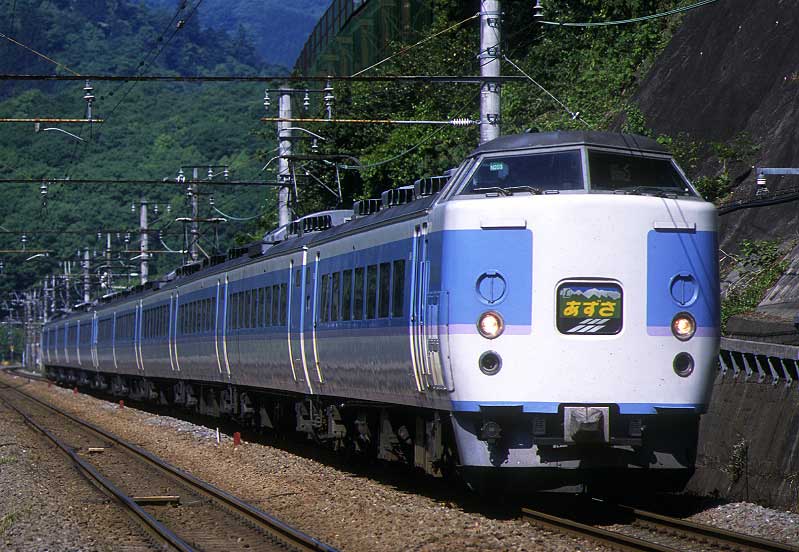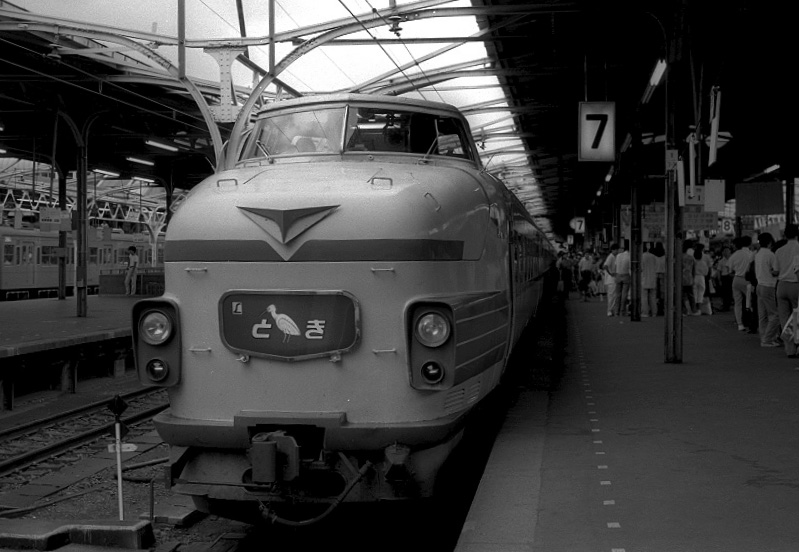|
183 Series
The was a Japanese limited express electric multiple unit (EMU) train type introduced in 1972 by Japanese National Railways (JNR). Following the privatization of JNR, the 183 series was operated by East Japan Railway Company (JR East) and West Japan Railway Company (JR-West). In terms of design, it is closely based on the late-model AC/DC 485 series, with minor cosmetic differences and DC-only drive. The last 189 series sets were withdrawn on 29 March 2019. The trains were built by Hitachi, Kawasaki Heavy Industries, Kinki Sharyo, Nippon Sharyo, and Tokyu Car Corporation. Former operations JR East * ''Azusa'' (seasonal only) * '' Kaiji'' (seasonal only) * ''Wing'' * ''Moonlight Shinshū'' * ''Moonlight Nagara'' * '' Sazanami'' * ''Wakashio'' * ''Shiosai'' * '' Ayame'' * '' Suigo'' * '' Toki'' * '' Amagi'' * ''Odoriko'' * '' Asama'' * '' Myōkō'' * '' Ohayō Liner'' * '' Chūō Liner'' (until March 2008) * '' Ōme Liner'' (until June 2002) JR-West The 183 series trains ope ... [...More Info...] [...Related Items...] OR: [Wikipedia] [Google] [Baidu] |
Kawasaki Heavy Industries
(or simply Kawasaki) is a Japanese Public company, public multinational corporation manufacturer of motorcycles, engines, Heavy equipment (construction), heavy equipment, aerospace and Military, defense equipment, rolling stock and ships, headquartered in Chūō-ku, Kobe, Chūō, Kobe and Minato, Tokyo, Minato, Tokyo, Japan. It is also active in the production of industrial robots, gas turbines, pumps, boilers and other industrial products. The company is named after its founder, Kawasaki Shōzō, Shōzō Kawasaki. KHI is known as one of the three major heavy industrial manufacturers of Japan, alongside Mitsubishi Heavy Industries and IHI Corporation, IHI. Prior to the World War II, Second World War, KHI was part of the Kobe Kawasaki ''zaibatsu'', which included JFE Holdings, Kawasaki Steel and K Line, Kawasaki Kisen. After the conflict, KHI became part of the DKB Group (''keiretsu''). History Kawasaki Shōzō, Shōzō Kawasaki, born in 1836, was involved with the marine indu ... [...More Info...] [...Related Items...] OR: [Wikipedia] [Google] [Baidu] |
485 Series
The (and the earlier 481 and 483 series variants) is a Japanese limited express electric multiple unit (EMU) type introduced in 1964 by Japanese National Railways (JNR), and subsequently operated by the East Japan Railway Company (JR East), West Japan Railway Company (JR-West), and Kyushu Railway Company (JR Kyushu). Approximately 1,500 vehicles were built, although by April 2016, JR East is the only operator still using this type. Variants * 481 series: Dual-voltage (1,500 V DC / 20 kV AC (60 Hz), introduced 1964 * 483 series: Dual-voltage (1,500 V DC / 20 kV AC (50 Hz), introduced 1965 * 485 series: Dual-voltage (1,500 V DC / 20 kV AC (50 Hz/60 Hz), introduced 1968 481 series The 481 series trains were introduced in 1964 for use on Hokuriku Line limited services, and were capable of operating under 1,500 V DC or 20 kV AC (60 Hz) overhead wire power supplies. These train were subsequently operated by JR-West and JR Kyushu. File:JNR-KURO481-1.jpg, ... [...More Info...] [...Related Items...] OR: [Wikipedia] [Google] [Baidu] |
Amagi (train) '', a Japanese light novel series
{{Disambiguation, geo, ship ...
Amagi may refer to: * Amagi, Fukuoka, a former city in Japan * Amagi, Kagoshima, a town in Japan * Mount Amagi, a range of volcanic mountains in Shizuoka Prefecture, Japan * Amagi Line (other), two Japanese railways * Amagi Station, a railway station in Fukuoka Prefecture, Japan * Ama-gi, an ancient Sumerian word and teaching * , an early vessel of the Imperial Japanese Navy * , a vessel in the Imperial Japanese Navy, sister ship of ''Akagi'' * , World War II * ''Amagi Brilliant Park is a Japanese light novel series written by Shoji Gatoh and illustrated by Yuka Nakajima. Fujimi Shobo has published eight volumes since February 20, 2013, under their Fujimi Fantasia Bunko imprint. J-Novel Club has licensed the series f ... [...More Info...] [...Related Items...] OR: [Wikipedia] [Google] [Baidu] |
Toki (train)
The is a high-speed Shinkansen train service operated by East Japan Railway Company (JR East) on the Joetsu Shinkansen in Japan. The name is taken from the Japanese name of the crested ibis, for which Niigata is famous. Station Stops * * * * * * * * * * * * * * * * * * * * * (*) Not served by all trains Rolling stock * E2 series 10-car sets (from 26 January 2013) * E7 series 12-car sets (''Toki'') (from 3 March 2019) File:E2 J63 omiya.JPG, An E2 series set File:Series-E7-F21.jpg, An E7 series set Former rolling stock * E1 series 12-car sets (''Max Toki'') (until 28 September 2012) * 200 series 10-car sets "K" sets (until 15 March 2013) * E4 series 8-car sets (''Max Toki'') (until 1 October 2021) File:JR East Shinkansen E1(renewal).jpg, A refurbished E1 series set File:JNR200-K51.jpg, A refurbished 200 series set File:Series-E4-P20.jpg, A refurbished E4 series set History Limited express The name ''Toki'' was first introduced on 10 June 1962 for limited express ... [...More Info...] [...Related Items...] OR: [Wikipedia] [Google] [Baidu] |
Ayame (train)
The was a limited express train operated by East Japan Railway Company (JR East) between , and via . First introduced in 1975, the last service ran on 13 March 2015. History The ''Ayame'' service was first introduced on 10 March 1975, initially as four return workings daily between Tokyo and Kashima-Jingu. The late 1980s saw increased competition from long-distance bus services between Tokyo and Kashima, and from the July 1993 timetable revision, the number of ''Ayame'' services was reduced to three return workings daily. In December 1994, services were further cut back, with just one up service in the morning and one down service in the evening. From the October 2004 timetable revision, the complementary ''Suigō'' limited express ( to via Narita Line) and ''Hometown Narita'' services were discontinued and the number of ''Ayame'' services was correspondingly increased to four up and two down services daily. From the start of the revised timetable on 10 December 2005, ''Aya ... [...More Info...] [...Related Items...] OR: [Wikipedia] [Google] [Baidu] |
Shiosai
The is a limited express train service in Japan operated by East Japan Railway Company (JR East). It runs from and to on the Bōsō Peninsula in Chiba Prefecture. Station stops ''Shiosai'' services operate over the Sōbu Main Line, stopping at the stations listed below. No services operate as "Local" all-stations services in any section; this characteristic is different from that of Wakashio ltd.exp.. - - - - - - - - - - * No.1 & 12 trains also stop at station. * No.2, 4 & 13 trains also stop at station. Rolling stock * 255 series 9-car EMUs (since 10 December 2005) * E257-500 series 5/10-car EMUs ''Shiosai'' services are operated using Makuhari-based 9-car 255 series EMU and 10-car E257-500 series EMU formations. The E257-500 series formations have no Green (first class) cars. Past rolling stock * 183 series EMUs (10 March 1975 – 2005) Formations Trains are formed as shown below, with car 1 at the Tokyo end. 9-car 255 series As of 2019, cars ... [...More Info...] [...Related Items...] OR: [Wikipedia] [Google] [Baidu] |
Wakashio
The is a limited express train service in Japan operated by the East Japan Railway Company (JR East). It runs from to and on the Bōsō Peninsula in Chiba Prefecture. Station stops ''Wakashio'' services operate over the Keiyo Line and Sotobo Line, stopping at the following stations. Some services terminate at Kazusa-Ichinomiya, and some services operate as "Local" all-stations services between Katsuura and Awa-Kamogawa. From March 2018, all trains pass through Ubara and Awa-Amatsu stations.Information about schedule change in March 2017 EAST JAPAN RAILWAY COMPANY Chiba branch、2017-12-15 - ※ - - ※ - - - - - - - ※ - - ※:Some trains pass through these stations. ''Shinjuku Wakashio'' services, operating mainly at weekends only, stop at the ... [...More Info...] [...Related Items...] OR: [Wikipedia] [Google] [Baidu] |
Sazanami (train)
The is a limited express train service in Japan operated by East Japan Railway Company (JR East). It runs between and via the Keiyo Line and Uchibō Line. Seasonal ''Shinjuku Sazanami'' services operate at certain weekends between Shinjuku and Tateyama. Principal stations served Tokyo - Soga - Goi - ( Anegasaki) - Kisarazu - Kimitsu Rolling stock * E257-500 series 5-car EMUs File:E257-500 NB-13 - Shinjuku Sazanami - Akihabara 20100502.jpg, A E257-500 series EMU on a ''Shinjuku Sazanami'' service in May 2010 at Akihabara Station Former rolling stock * 255 series 9-car EMUs * 183/189 series 9-car EMUs File:Jr183-snjsazanami-skw-kiw.jpg, A 189 series EMU on a ''Shinjuku Sazanami'' service in February 2007 File:JR East 255 Limited Express Sazanami.jpg, A 255 series EMU on a ''Sazanami'' service in March 2008 History * 15 July 1972 - ''Sazanami'' service starts coinciding with opening of the underground Sōbu Line platforms at Tokyo Station. * 16 March 1991 - ''Saz ... [...More Info...] [...Related Items...] OR: [Wikipedia] [Google] [Baidu] |
Moonlight Nagara
The was a seasonal rapid overnight train service operated by East Japan Railway Company (JR East) and Central Japan Railway Company (JR Central), which ran from to in Gifu Prefecture via the Tokaido Main Line. From 2009, the service had been offered approximately three weeks per year, corresponding to the spring, summer and year-end holiday seasons. On 22 January 2021, both East Japan Railway Company (JR East) and Central Japan Railway Company (JR Central) announced the cessation of the Moonlight Nagara services with no replacements offered at the time, due to the increased popularity of highway buses and the ageing trains operated on the line. Since the train service had not operated during the summer and winter of 2020 due to the COVID-19 situation, this announcement made 29 March 2020, the last day of operations of the Nagara service. That day also marked the complete cessation of the "Moonlight"-branded services from Japan. Rolling stock From December 2013, ''Moonlight Na ... [...More Info...] [...Related Items...] OR: [Wikipedia] [Google] [Baidu] |
Moonlight Shinshū
The was a seasonal overnight Rapid service operated by East Japan Railway Company (JR East), which ran between Shinjuku and Hakuba Station via the Chūō Main Line, Shinonoi Line, and Ōito Line. The service started in 2002, and is operated using 6- or 9-car 183 series or 189 series EMUs. While JR East has not formally announced its discontinuation, no services have operated since December 30, 2018.https://kakuyasu-ryoko.com/railway/special-train/%E3%83%A0%E3%83%BC%E3%83%B3%E3%83%A9%E3%82%A4%E3%83%88%E4%BF%A1%E5%B7%9E/ Route The main station stops for the ''Moonlight Shinshū'' service were as follows, although the exact stopping patterns vary depending on the time of year. * Shinjuku - Tachikawa - Hachiōji - Takao - Ōtsuki - Enzan - Kōfu - Kobuchizawa - Fujimi - Chino - Kami-Suwa - Shimo-Suwa - Okaya - Shiojiri - Matsumoto - Shinano-Ōmachi - Hakuba is a village located in Nagano Prefecture, Japan. , the village had an estimated population of 9,007 in 4 ... [...More Info...] [...Related Items...] OR: [Wikipedia] [Google] [Baidu] |
Kaiji (train)
The is a limited express train service in Japan operated by East Japan Railway Company (JR East). It runs mainly between Shinjuku Station in Tokyo and Kōfu Station in Kōfu, Yamanashi via the Chūō Main Line. ''Chiba Kaiji'', between Chiba and Ryūō, ''Hamakaiji'', between Yokohama and Matsumoto, ''Yama Kaiji'', Between Tachikawa and Kobuchizawa, also exist as seasonal variants. Route ''Kaiji'' - (Some trains operate between and .) ''Chiba Kaiji'' - - ''Hamakaiji'' - - Yama Kaiji Tachikawa - Kobuchizawa Rolling stock From 2018, new E353 series EMUs were introduced on ''Kaiji'' services, replacing the E257 series trains. The new trains feature power outlets for passenger use and WiFi internet service. ''Kaiji'' *E353 series EMUs (since 1 July 2018) ; Former *E257 series EMUs (from 2001 to 15 March 2019) * 183/189 series EMUs (regular services until 2002 and seasonal extra services until 2018) ''Chiba Kaiji'' *E257-500 series ''Hamakaiji'' * 185 series ... [...More Info...] [...Related Items...] OR: [Wikipedia] [Google] [Baidu] |


